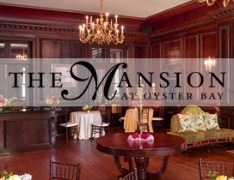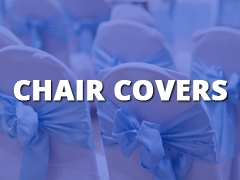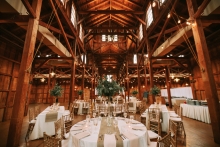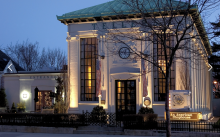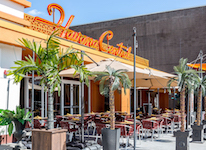Looking for answers to customer support questions? Click Here
Behind The Scenes: The “TRADITION” Of Getting Married
Besides our own culture and customs passed down from generation to generation, we all follow standard protocol when it comes to the pomp and circumstance of our nuptials. And, when it comes to these rich wedding traditions, they have quite a rich and interesting history.
1. The Bell Of The Ball Gown: Soon-to-be-brides of days gone by usually wore the nicest thing in their closet to tie the knot…and NOT a grandiose, glamorous gown….and believe it or not it, did not have to be white. In fact, often times the bride adorned herself in frocks of fur, silk and velvet to convince her groom that she came from a family of stature, which would make her more attractive to her groom to be. So, where did the grand white gown come from? You can thank Queen Victoria (who reigned from 1837-1901) who wed Prince Albert (in 1840) wearing a pale gown trimmed with orange blossoms for HER big day. Because it was fashionable, much like today, to emulate the Queen, this style became the “new norm” and has remained the standard ever since.
2. Giving His “Baby Girl” Away: Forget the sentimentality of today’s dad walking his “favorite lady” down the aisle and reluctantly handing her over to her groom. This tradition was not quite so “romantic”. In fact, it came about because girls were considered “property” and as potential “currency”…and dad was merely making a peace offering or paying off a debt by offering his daughter as a bride. This bride price was typically made to a tribe or family that had “more to offer”. It was THE way to ensure the family “moved up in the world”….and could be equated with dad buying his way up the “corporate” or social ladder.
3. Bridesmaids and Groomsmen: The best man was the original version of the ultimate “wing man”. He historically stood by the groom’s side (because many ancients such as Goths, Visigoths and Huns) took their brides by force) to help him fight off disapproving parents. As for bridesmaids, they were intended to dress similarly to the bride and serve as “distractions” from evil spirits and jealous ex-lovers that would interfere from the bride taking her vows and tying the knot. The same holds true for the formal tuxedo, intended to save the groom from the same fate. The Maid of Honor also had the distinct duty of hand-crafting all the wedding décor and decorating for the wedding all by herself….making her the original “Day Of Coordinator”.
4. Traditional Wedding Day Tosses: Tossing out your garter belt and the bridal bouquet have some seriously “off-color” origins. Brides and grooms were expected to “make the marriage official” immediately after the “I Dos”…and with plenty of witnesses in full view. Ladies would claw at the bride’s gown as it was being torn from her body hoping for some luck (in the romance department). However, time changed this tradition and what transpired was today’s “translation” of tossing the garter and the bouquet. By the way…brides of days the past carried bundles of herbs (now replaced by the bouquet) to ward off evil spirits.
5. Sentimental Sayings: We’re all familiar with “Something Old, Something New, Something Borrowed, Something Blue…(And A Sixpence In My Shoe)”. Again, this tradition stems from ancient superstition…and this particular saying stems back to the Victorian age and each “ritual” was intended to bring the bride good fortune. Something old referred to the bride’s attachment to her family and her past while the something new referred to her new life as a wife and as the property of a new family. The something borrowed was typically something from someone already successfully wed (to bring good luck to the new couple)…and the something blue was symbolic of the Virgin Mary and represented faithfulness, purity and loyalty. As for the sixpence, it was representative of prosperity and wealth for the newlyweds.
6. Sweet Nothings: So, why do we have a cake cutting “ceremony”? Better yet, why do couples try to smash cake in each other’s face? This is simply the evolution of a tradition from days of yore. The groom would take a bite of barley bread (for himself) then crumble the rest over the bride’s head showing his male dominance. Guests would then make a bee line for wayward crumbs as they were supposed to bring good luck. As the tradition evolved, cakes replaced barley bread and instead of it being broken over the bride’s head, this sweet confection was cut at the table and then the bride would hand out small morsels (that had been blessed) to waiting guests through her wedding ring. This further evolved into slices of cake being handed out to guests, not for consumption but for placing under their pillow for good luck, and for ladies, as a means of eliciting sweet dreams of a future mate.
7. Save-The-Cake: The tradition of freezing the top layer of our wedding cake and eating it on our anniversary a year later may seem silly, and not very tempting (if you consider freezer burn).. but it’s origins stem from a popular children’s rhyme “First comes love, then comes marriage, then comes baby in a baby carriage”. Back in the day, it was presumed that children naturally followed the wedding night and the honeymoon…and with people being more practical and frugal, it was a way of saving money on cake. Instead, they would freeze the leftovers to be consumed for the joyous celebration of their little one’s arrival and/or his or her Christening. Eventually, the notion of another cake became popular but couples still maintained the custom of saving part of their cake for enjoying on their first anniversary.
8. Rice, Rice Baby: Throwing rice (today couples also get pelted with flower petals, bubbles, etc) was a way of showering the new couple with prosperity, fertility and blessings of good fortune.
1. The Bell Of The Ball Gown: Soon-to-be-brides of days gone by usually wore the nicest thing in their closet to tie the knot…and NOT a grandiose, glamorous gown….and believe it or not it, did not have to be white. In fact, often times the bride adorned herself in frocks of fur, silk and velvet to convince her groom that she came from a family of stature, which would make her more attractive to her groom to be. So, where did the grand white gown come from? You can thank Queen Victoria (who reigned from 1837-1901) who wed Prince Albert (in 1840) wearing a pale gown trimmed with orange blossoms for HER big day. Because it was fashionable, much like today, to emulate the Queen, this style became the “new norm” and has remained the standard ever since.
2. Giving His “Baby Girl” Away: Forget the sentimentality of today’s dad walking his “favorite lady” down the aisle and reluctantly handing her over to her groom. This tradition was not quite so “romantic”. In fact, it came about because girls were considered “property” and as potential “currency”…and dad was merely making a peace offering or paying off a debt by offering his daughter as a bride. This bride price was typically made to a tribe or family that had “more to offer”. It was THE way to ensure the family “moved up in the world”….and could be equated with dad buying his way up the “corporate” or social ladder.
3. Bridesmaids and Groomsmen: The best man was the original version of the ultimate “wing man”. He historically stood by the groom’s side (because many ancients such as Goths, Visigoths and Huns) took their brides by force) to help him fight off disapproving parents. As for bridesmaids, they were intended to dress similarly to the bride and serve as “distractions” from evil spirits and jealous ex-lovers that would interfere from the bride taking her vows and tying the knot. The same holds true for the formal tuxedo, intended to save the groom from the same fate. The Maid of Honor also had the distinct duty of hand-crafting all the wedding décor and decorating for the wedding all by herself….making her the original “Day Of Coordinator”.
4. Traditional Wedding Day Tosses: Tossing out your garter belt and the bridal bouquet have some seriously “off-color” origins. Brides and grooms were expected to “make the marriage official” immediately after the “I Dos”…and with plenty of witnesses in full view. Ladies would claw at the bride’s gown as it was being torn from her body hoping for some luck (in the romance department). However, time changed this tradition and what transpired was today’s “translation” of tossing the garter and the bouquet. By the way…brides of days the past carried bundles of herbs (now replaced by the bouquet) to ward off evil spirits.
5. Sentimental Sayings: We’re all familiar with “Something Old, Something New, Something Borrowed, Something Blue…(And A Sixpence In My Shoe)”. Again, this tradition stems from ancient superstition…and this particular saying stems back to the Victorian age and each “ritual” was intended to bring the bride good fortune. Something old referred to the bride’s attachment to her family and her past while the something new referred to her new life as a wife and as the property of a new family. The something borrowed was typically something from someone already successfully wed (to bring good luck to the new couple)…and the something blue was symbolic of the Virgin Mary and represented faithfulness, purity and loyalty. As for the sixpence, it was representative of prosperity and wealth for the newlyweds.
6. Sweet Nothings: So, why do we have a cake cutting “ceremony”? Better yet, why do couples try to smash cake in each other’s face? This is simply the evolution of a tradition from days of yore. The groom would take a bite of barley bread (for himself) then crumble the rest over the bride’s head showing his male dominance. Guests would then make a bee line for wayward crumbs as they were supposed to bring good luck. As the tradition evolved, cakes replaced barley bread and instead of it being broken over the bride’s head, this sweet confection was cut at the table and then the bride would hand out small morsels (that had been blessed) to waiting guests through her wedding ring. This further evolved into slices of cake being handed out to guests, not for consumption but for placing under their pillow for good luck, and for ladies, as a means of eliciting sweet dreams of a future mate.
7. Save-The-Cake: The tradition of freezing the top layer of our wedding cake and eating it on our anniversary a year later may seem silly, and not very tempting (if you consider freezer burn).. but it’s origins stem from a popular children’s rhyme “First comes love, then comes marriage, then comes baby in a baby carriage”. Back in the day, it was presumed that children naturally followed the wedding night and the honeymoon…and with people being more practical and frugal, it was a way of saving money on cake. Instead, they would freeze the leftovers to be consumed for the joyous celebration of their little one’s arrival and/or his or her Christening. Eventually, the notion of another cake became popular but couples still maintained the custom of saving part of their cake for enjoying on their first anniversary.
8. Rice, Rice Baby: Throwing rice (today couples also get pelted with flower petals, bubbles, etc) was a way of showering the new couple with prosperity, fertility and blessings of good fortune.

Welcome New Vendors
- The Barn At Old Bethpage Discover the charm a...
- Jack & Rose Jack & Rose Floral D...
- Tellers: An American Chophouse Tellers: An American...
- Cup Of Tea Creative Unique Wedding Gifts...
- Speeches for Milestones The Big Day Has Ar...
- Long Island Bridal Expo Connecting Brides & ...
- 1 More Rep 1 More Rep offers Ap...
- Bellport Inn The Bellport Inn –...
- Snapphotto Snapphotto is one of...
- Fiddlers Dream Music Asher began classica...
- Havana Central Featuring real Cuban...
- Primerica Nelida Flynn Founded in 1977 on t...
X
Sign In
Sign in with Social Networking
By Signing in with Facebook or Google, You accept LIWedding Terms of use and Privacy Policy
X
Create an Account
Sign up with Social Networking
By Signing up with Facebook or Google, You accept LIWedding Terms of use and Privacy Policy
Already have an Account ? Sign In
X






